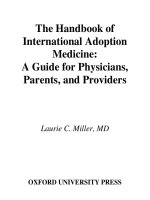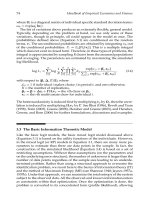the handbook of international trade and finance
Bạn đang xem bản rút gọn của tài liệu. Xem và tải ngay bản đầy đủ của tài liệu tại đây (1.1 MB, 208 trang )
London and Philadelphia
ANDERS GRATH
International
Trade and Finance
The Complete Guide to Risk Management, International
Payments and Currency Management, Bonds and
Guarantees, Credit Insurance and Trade Finance
THE HANDBOOK OF
CGT Int'l Trade Finance TP:Layout 1 30/4/08 12:54 Page 1
Publisher’s note
Every possible effort has been made to ensure that the information contained in this book is
accurate at the time of going to press, and the publishers and authors cannot accept responsibility
for any errors or omissions, however caused. No responsibility for loss or damage occasioned
to any person acting, or refraining from action, as a result of the material in this publication can
be accepted by the editor, the publisher or any of the authors.
First published in Great Britain in 2005 by Nordia Publishing Ltd for The Institute of Export as
International Trade Finance
Published in Great Britain and the United States in 2008 by Kogan Page Limited as The
Handbook of International Trade and Finance
Apart from any fair dealing for the purposes of research or private study, or criticism or review,
as permitted under the Copyright, Designs and Patents Act 1988, this publication may only be
reproduced, stored or transmitted, in any form or by any means, with the prior permission in
writing of the publishers, or in the case of reprographic reproduction in accordance with the
terms and licences issued by the CLA. Enquiries concerning reproduction outside these terms
should be sent to the publishers at the undermentioned addresses:
120 Pentonville Road 525 South 4th Street, #241
London N1 9JN Philadelphia PA 19147
United Kingdom USA
www.koganpage.com
© Anders Grath, 2005, 2008
The right of Anders Grath to be identified as the author of this work has been asserted by him in
accordance with the Copyright, Designs and Patents Act 1988.
ISBN 978 0 7494 5320 6
British Library Cataloguing-in-Publication Data
A CIP record for this book is available from the British Library.
Library of Congress Cataloging-in-Publication Data
Grath, Anders, 1943–
The handbook of international trade and finance : the complete guide to risk management,
bonds and guarantees, credit insurance and trade finance / Anders Grath.
p. cm.
Includes index.
ISBN 978-0-7494-5320-6
1. International trade. 2. International finance. I. Title.
HF1379.G725 2008
382– –dc22
2008010589
Typeset by JS Typesetting Ltd, Porthcawl, Mid Glamorgan
Printed and bound in Great Britain by Bell & Bain Ltd, Glasgow
Contents
Preface vii
Acknowledgements/Disclaimer ix
Introduction 1
1 Trade risks and risk assessment 9
International trade practices 9
Product risks 14
Commercial risks (purchaser risks) 18
Adverse business risks 20
Political risks 22
Currency risks 24
Financial risks 26
2 Methods of payment 29
Different methods of payment 29
Bank transfer (bank remittance) 32
Cheque payments 40
Documentary collection 42
Letter of credit 47
Counter-trade 65
3 Bonds, guarantees and standby letters of credit 69
The use of bonds and guarantees 69
Common forms of guarantee 76
Demand guarantees 80
Standby letters of credit 83
The structure and design of guarantees 85
iv CONTENTS
__________________________________________________________
4 Currency risk management 89
Currency risk 89
The currency markets 91
Currency exposure 95
Hedging currency risks 98
Practical currency management 105
5 Export credit insurance 109
A mutual undertaking 109
The private sector insurance market 112
Export credit agencies 116
Investment insurance 123
6 Trade finance 125
Finance alternatives 125
Pre-shipment finance 127
Supplier credits 130
Refinancing of supplier credits 134
Buyer credits 141
The international money market 145
7 Structured trade finance 149
International leasing 149
Lines of credit and local currency finance 154
Project finance and joint venture 155
Multilateral development banks 158
8 Terms of payment 163
Terms of payment and cash management 163
Contents of the terms of payment 164
Structure of the terms of payment 168
Composite terms of payment 172
The final design of the terms of payment 174
Glossary of terms and abbreviations 177
Index 193
Index of advertisers 198
THIS PAGE INTENTIONALLY
LEFT BLANK
v
THIS PAGE INTENTIONALLY
LEFT BLANK
vi
Preface
This handbook was originally published more than 20 years ago, and has since been
updated in new editions. It has also been published as separate country-specific
editions in several European countries where it has become a reference handbook for
companies, banks and other institutions involved in international trade, irrespective of
their size or the nature of their business.
However, for practical reasons it would not be possible to cover more than a
handful of countries in this way, and for some time I have been considering doing a
completely new and country-neutral edition that could be marketed in most countries
involved in international trade around the world. The only drawback is that it is not
feasible to describe the specifics for every country; on the other hand, the basic aspects
of international trade, payments and finance are almost the same all over the world,
and that is the foundation for this new handbook.
There is great advantage in being able to combine this basic description with
numerous references to places where country-specific information in a number of
areas can be found. This information is readily available from internet sites from a
variety of domestic institutions in most countries. Therefore it has been possible to
create a situation where this book provides the foundation but readers from all over
the world can add all the detailed and country-specific information they require. There
is another big advantage in such an approach, namely that the basics of this handbook
should be relatively stable over time, whereas detailed information from local and
domestic institutions will certainly change over time; however, these changes will be
constantly communicated through local internet services.
Even though new editions have been published in different countries over the
years, they have all been based on the same concept: their practical nature. They
contain no theoretical elements, just information based on the author’s almost 30
years of payment and finance experience gained from managerial positions as head of
international departments in a number of European banks. Those in such positions are
necessarily involved in thousands of trade transactions each year, and the advice and
comments given in this book are based on that experience.
viii The HANDBOOK OF INTERNATIONAL TRADE AND FINANCE
________________________
I am very pleased with this new international edition now published by Kogan Page,
and feel confident that it will become the reference handbook of choice in numerous
countries around the world, for many years to come. It will certainly be of significant
benefit to all international traders in the daily work of expanding their businesses or
when entering new global markets, but the book will equally be used in trade education
and within the international departments of commercial banks and other trade-related
institutions around the world.
Acknowledgements/
Disclaimer
The author would like to thank the companies, banks and other institutions that have
contributed with support, advice and comments when creating this book; however,
the author is solely responsible for the views, illustrations and recommendations
expressed.
While every care has been taken to ensure the accuracy of this work, no responsi-
bility for loss occasioned to any person or company acting or refraining from action as
a result of any statement in it can be accepted by the author or publisher.
THIS PAGE INTENTIONALLY
LEFT BLANK
x
Introduction
An international trade transaction, no matter how straightforward it may seem at the
start, is not completed until delivery has taken place, any other obligations have been
fulfilled and the seller has received payment. This may seem obvious; however, even
seemingly simple transactions can, and sometimes do, go wrong.
There are many reasons why these things happen, but behind them all is the basic
fact that the risk assessment of the transaction and/or the way these risks were covered
went wrong. An example is the risk assessment of the customer, where exporters do not
always fully realize that the larger countries may be divided into regions, often with
different cultures, trade patterns and practices. In many countries, signed contracts are
sometimes considered to be merely letters of intent, particularly if they have not been
countersigned by a senior authorizing manager. Or it may be that the seller has agreed
to terms that were previously used but are not suitable in a new situation.
Another reason may be that the parties simply did not use the same terminology
or did not focus on the details of the agreed terms of payment. This would inevitably
lead to undefined terms, which are potentially subject to future disputes, something
that would perhaps not be revealed until delivery has been made – when the seller is
in a weaker bargaining position. Even though such errors seldom lead to non-payment,
it is more likely that they will lead to delays in payment, possibly with an increased
commercial and/or political risk as a consequence.
Another common consequence of unclear or undefined terms of payment is that
the seller may have outstanding claims on the buyer; or that the buyer is of the same
opinion with regard to the seller and takes the opportunity to make unilateral payment
deductions owing to real or alleged faults or deficiencies in the delivery.
Each area of international trade requires its own knowledge to be used, from the
first contacts between buyer and seller to final payment. One area of expertise is how
to develop professional and undisputed terms of payment and, if necessary, how to
solve currency and trade finance questions in a competitive way. These areas are of
vital importance both in the offer and in subsequent contract discussions, not just
2 The HANDBOOK OF INTERNATIONAL TRADE AND FINANCE
_________________________
Table 0.1 Leading exporters and importers in world merchandise trade, 2006 (billion
US$)
Country Export Import
Germany 1112 909
United States 1038 1919
China 969 792
Japan 650 580
France 490 535
Netherlands 462 416
United Kingdom 448 619
Italy 410 437
Canada 390 358
Belgium 369 354
Rep. of Korea 326 310
Hong Kong 323 336
Russia 305 164
Singapore 272 239
Mexico 250 268
Taipei, Chinese 224 203
Saudi Arabia 210 66
Spain 206 316
Malaysia 161 131
Switzerland 148 141
Sweden 147 127
Austria 140 140
United Arab Emirates 139 98
Brazil 138 96
Thailand 131 129
Australia 123 139
Norway 122 64
India 120 175
Ireland 111 73
Poland 110 126
Indonesia 104 80
Czech Republic 95 93
World 12.083
Source: WTO, World Trade statistics 2007
( />_______________________________________________________
INTRODUCTION 3
within difficult countries or markets or in larger, more complicated deals, but also in
quite ordinary day-to-day transactions.
The choice of currency could be of great importance, particularly in an increasingly
competitive market, and the ability to extend finance has become a major competitive
factor in negotiations. But the terms of such credits have changed to the advantage of
the buyer and, as a consequence, demand for longer periods and more advantageous
terms has increased.
Terms of payment, currency and finance alternatives can, in some cases, and/or in
similar and repetitive transactions, be developed as standard models but must, in other
cases, be adapted to each transaction and its specific preconditions. This is even more
obvious if one looks at Table 0.1 and Figure 0.1 and evaluates the basic structure of
international trade.
There are more than 150 other countries, including many developing and emerging
markets countries, which are not even listed, and in many of these, the structuring of
the terms of payment is the key to more frequent and profitable business.
Figure 0.1 World merchandise exports by product group, 2006
Source: WTO, World Trade statistics 2007
( />Non-ferrous metals ($306bn)
Ores and minerals ($201bn)
Fuels ($177bn)
Iron and steel ($374bn)
Other machinery ($1448bn)
Scientific and controlling instruments ($240bn)
Pharmaceuticals ($311bn)
Office and telecom equipment ($1451bn)
Other chemicals ($937bn)
Other semi-manufactures ($795bn)
Clothing ($311bn)
Agricultural products ($945bn)
Automotive products ($1015bn)
Textiles ($219bn)
Annual percentage change
0
5
10
15
20
25
30
35
40
45
50
55
Average
4 The HANDBOOK OF INTERNATIONAL TRADE AND FINANCE
_________________________
Every transaction contains many different preconditions, apart from aspects
such as the buyer, the country, the nature of the goods, size, extent and complexity.
This requires the seller to carry out an individual risk assessment and make decisions
that ensure a profitable and secure deal, with a level of risk that is both defined and
accepted at the outset.
It is therefore of great importance, for both buyer and seller, to know how to
structure practical terms of payment. In practice this often means that during nego-
tiations the seller must be willing and able to compromise – even when it comes to
specific questions related to guarantees, payments, currency and finance. In these
situations, and often together with other difficult negotiations, it is important to
understand the connections between these parts, what is essential to hold on to and
what can be waived.
Any successful negotiation must take reasonable and equal consideration of
the demands from both commercial parties in order to find a compromise and avoid
unnecessary discussions or misunderstandings. The experienced seller will always
try to avoid such situations, thereby strengthening the potential for future business
transactions, provided that fundamental demands have been met to safeguard the
transaction.
This handbook should be used as a reference manual in the practical day-to-day
business of the international trading company within the sales, shipping, administrative
and back-office departments. For small and medium-sized companies that do not
always have the specialist finance functions in-house this is obvious. But this will also
be the case even within the largest companies, where specialization often means that
many employees have detailed knowledge in some, but not all, financial areas.
And that goes not only for the exporting company, but also within importing
companies buying goods or services from abroad. Many comments have been made
about the advantages of describing, in practical detail, the interactive negotiating
process between the commercial parties in an international trade transaction; useful
knowledge for both the seller and the buyer.
That is exactly the way these handbooks have been used for over 25 years.
Cash management
One important development over recent years has been the demand for capital
rationalization, or ‘cash management’. This has affected all aspects of business,
not least the sections covered in this handbook. It is especially obvious within
the areas of payment, currency and finance where every decision has direct
consequences on the capital required during all phases of the transaction, until
payment is received.
This handbook demonstrates primarily how the seller can act, within the
framework of a defined risk level and with their competitive edge maintained, to
optimize the profitability of international trade transactions. They can then also
determine, with a high degree of accuracy, when, where and how payments will
_______________________________________________________
INTRODUCTION 5
be made and therefore how to minimize the capital required. The concept of risk
is directly connected to the probability of timely payment, the choice of currency
related to the exchange rate when paid and the financing connected to the cost of
the outstanding credit. The importer will use the same knowledge, but from their
own perspective.
The expression ‘cash management’ is seldom explicitly used in the text,
but most sections contain comments or advice that, directly or indirectly, has a
bearing on the use and latent risk of capital. With this in mind, this handbook
could be read as a manual for improved cash management in connection with
international trade (more on this is explained in the final chapter concerning the
practical structure and design of the terms of payment).
The main composition of this handbook
This handbook is intended to be a practical reference guide to help in the
daily work – mainly seen from the perspective of the seller – within sales,
shipping and administration. The contents have, therefore, been structured as
follows:
risks and risk assessment (analysis);
methods of payment
guarantees, bonds and standby L/Cs
export credit insurance
currency risk management (alternatives);
trade finance
structured trade finance
structure and design of practical terms of payment (action).
To get a clearer picture of the focus of this handbook, please also consider this
statement before browsing through the following pages.
6 The HANDBOOK OF INTERNATIONAL TRADE AND FINANCE
_________________________
From the seller’s perspective. . . Why are some companies doing more frequent
and successful export deals than others. . .?
. . . It is because they manage to cover even the most difficult export risks
– only then are they in the best position to enter totally new markets.
Sell more – win market shares – enter new markets. Who doesn’t want that? But the
problem is often not making the sale but ensuring that you get paid.
Why do things sometimes go wrong in the export chain, from quotation to payment
– or in the worst case, non-payment? The answer is that the seller often underestimates,
or simply does not fully understand, the risks involved in the transaction. Or the seller
does not get the terms of payment originally anticipated and, at that stage, does
not manage to cover the transaction in some other way – or even abstains from the
deal altogether. Basically it is a matter of learning how to cover the trade risks in a
professional way – allowing the seller to manage transactions in most parts of the
world.
Figure 0.2 Expanding exports into new markets can be very profitable – if you can
control the risks
_______________________________________________________
INTRODUCTION 7
. . . However, the follow-up must also be done professionally at home. What is
needed is effective handling of the transaction until shipment occurs – and thereafter,
effective debt supervision. Time is money – look at the time arrow in Figure 0.3.
The follow-up starts immediately after the contract is signed. It can be a forward
currency hedge, the issuing of guarantees, communication with the insurance company
about an export credit risk policy or follow-up of the obligations of the buyer, for
example the correct issue of a letter of credit.
To end up in the grey area of the time arrow is always risky; there the seller is
more exposed – the goods have been shipped but without the payment being received
in time.
Worst of all, if pre-shipment control is not in place, even the most secure letter
of credit will be worthless if the seller is not able to comply fully with its terms
later on. It is often in sales negotiations in foreign countries far away from the home
organization that the details for a profitable transaction have to be decided. And once
the deal is signed, it may be difficult to get changes to the advantage of the seller – not
least regarding the terms of payment.
The follow-up is crucial and will ultimately decide the profitability of the
transaction.
Figure 0.3 By shortening the time arrow within each segment, the risk situation can be
improved – in the same way as liquidity and profitability.
quotation
order
delivery
invoice
due date
remainder 1
remainder 2
collection
date of payment
Time of
delivery
Production
Approved
credit
Hidden
credit
UNAPPROVED CREDIT
THIS PAGE INTENTIONALLY
LEFT BLANK
8
1
Trade risks and risk
assessment
International trade practices
All forms of business contain elements of risk, but when it comes to international trade,
the risk profile enters a new dimension. Internationally, you seldom have common
laws that can support the transaction, as would be the case within one country. Instead,
established trade practices and conventions are used to settle the undertakings made
by the parties.
The key to successful trade transactions, therefore, depends on a knowledge of
these established practices and ensuring that the undertakings in the individual contract
are in line with such practices. This is why it is crucial for the seller to have started
with a correct risk assessment before finally entering into the transaction. Sometimes,
however, the circumstances in a particular case are so obvious that one hardly thinks
of it as a risk assessment, whereas in other situations a thorough risk assessment needs
to be done.
The main sources for international trade practices are publications issued by the
International Chamber of Commerce (ICC), which will be referred to many times
throughout this book.
In every new transaction one has to take it for granted that, from the outset, the
parties will have different views about various aspects of the terms of payment. This
is quite logical since the most important function of these terms for both seller and
buyer is to minimize not only the risks involved, but also the cost of payment and of
the financing of the transaction.
10 The HANDBOOK OF INTERNATIONAL TRADE AND FINANCE
________________________
The negotiation process
The seller will always try to get terms that will maximize the outcome and minimize
the risk. However, they must also be prepared to accommodate reasonable demands
from the buyer in order to match other competitors and reach a deal that is acceptable
to both parties, thereby also developing a good long-term business relationship.
Should the seller be inflexible on this point, it could result in an adverse competitive
situation with the potential risk of losing the deal. On the other hand, demands from
the buyer that are too stringent can have the same result, or be resolved by means of a
higher price or some other amendment to the final agreement.
The outcome of these negotiations will depend on past knowledge and experience,
which is even more important if the buyer bases their request for tender on simplified
or standardized terms of payment, usually to their own advantage. In many cases,
such terms are adapted to conditions that are not optimal for the seller, compared with
what the seller could have reached if they were individually negotiated. In such a case
it is important to be able to argue and convince the buyer that there might be other
solutions that can satisfy any reasonable demands, in order to find the optimal result
for both parties.
There is, however, another – and in some countries very common – way to
bridge the gap between the parties, if the seller has to abstain from some demands
in negotiations with the buyer. The seller could approach a third party, often a credit
insurance company, in order to reduce the commercial risk which could not be covered
through the agreed terms of payment.
Finally, it should be noted that the business practices which have been established
over time in different countries or regions also create at least a common ground for
both parties when starting their payment negotiations, ie choice of currency, form
of payment and terms of financing. Local banks, trade councils and the chambers of
commerce in both the seller’s and the buyer’s country can draw on their experience and
give impartial advice on local business practice regarding both the form of payment
and the more specific terms of payment, while also taking the size, commodity and
other aspects of the potential transaction into account. Such considerations can then be
the starting point for negotiations between the parties.
Different forms of trade risk
There are always potential drawbacks in trying to categorize such a general concept as
trade risks which could have so many different forms and shapes, but it also has great
illustrational advantages, particularly when they also coincide with commonly used
business expressions. Figure 1.1 shows the main risk structure in international trade,
which will affect both the seller’s and the buyer’s view of the terms of payment.
Obviously, all these risks combined do not often occur in one and the same
transaction. For example, a sale to a Norwegian customer in USD may be just a matter
of a straight commercial risk on the buyer, whereas delivery of a tailor-made machine
to Indonesia has to be risk assessed in quite another way.
In quite general terms, the risk structure is directly linked to the obligations
undertaken by the seller. This assessment can often be made relatively simple as a
_______________________________________
TRADE RISKS AND RISK ASSESSMENT 11
commercial risk only, but, in other cases, for example if the transaction also involves
assembly, installation, testing or a maintenance responsibility, the assessment has to
involve many other aspects as well.
The question of risk is to a large degree a subjective evaluation, but it is still
important for both parties to have a good knowledge of these matters in order to
carry out a proper and meaningful risk assessment. Only thereafter does the question
arise about how to cover these risks through the terms of payment together with
other limitations in the contract, if applicable, and together with separate credit risk
insurance or guarantees, as the case may be.
It should also be noted that most export credit insurance, taken by the seller as
additional security, could be impaired or even invalid should the seller themselves not
have fulfilled – or been able to fulfil – their obligations according to the contract. This
is another reason why it is so important that the obligations of the seller, according to
the contract, are always directly related to those of the buyer. Otherwise the seller may
end up in a risk situation that is worse than anticipated at the time of entering into the
contract.
When all the necessary evaluations have been done, the final decision as to whether
the deal is secure enough to be entered into has to be taken. The worst that can happen
is finding, after the contract has been signed, that it contains risks that the seller was
unaware of at that time. It is then often too late to make changes.
Terms of delivery and terms of payment
This handbook describes in detail the structure and design of the terms of payment
as an integral part of the contract. However, the terms of delivery also have to be
Figure 1.1 Different forms of risk in international trade
Financial risks
Currency risks Political risks
Commercial
risks
Adverse business
risks
Product,
production and
transport risks
Main trade
risks
12 The HANDBOOK OF INTERNATIONAL TRADE AND FINANCE
________________________
defined in order to determine when and where the seller has fulfilled the obligations to
deliver according to the contract and what is needed in order to do so. There is a clear
connection between these two sets of terms insofar as payment is mostly related to the
point at which the risk passes from the seller to the buyer as specified by the terms of
delivery; it is to be made either at that particular time or at a specific time thereafter.
This connection makes it necessary to outline some basic facts about the different
terms of delivery.
The standard rules of reference for the interpretation of the most commonly
used trade terms in international trade are Incoterms 2000 (International Commercial
Terms), issued by the International Chamber of Commerce (ICC), Publication
560. These rules are now generally recognized throughout the world, so any other
unspecified trading terms, which may often have different meanings for companies in
different countries, should be avoided. When agreed upon between the parties, these
rules and their latest revisions must always be referred to in the sales contract and in
all related documentation, for example CIF Hong Kong, Incoterms 2000.
The basic purpose of these rules is to define how each Incoterm, as agreed in the
sales contract, should be dealt with in terms of delivery, risks and costs, and specify
the responsibility of the buyer and seller. For example, who should arrange and pay
freight, other transport charges, insurance, duties and taxes? These aspects are often
referred to as the critical points in international trade, detailing at what point the risk
is transferred from the seller to the buyer and how the costs involved should be split
between the parties.
There are presently 13 defined Incoterms, split into four groups, related to the
seller’s obligation to deliver the goods. Some Incoterms can be used only for maritime
transport whereas others can be used for all modes of transport; similarly, some are
more suitable than others for use in combination with terms of payment based on
‘clean payments’ in connection with open account trading, while others are used in
combination with ‘documentary payments’. These four groups are:
Group E – where the seller has to make the goods available at their premises. The
only example is EXW – Ex Works (named place), where the seller must place the
goods at the disposal of the buyer at the seller’s premises or another named place
not cleared for export and not loaded on any collecting vehicle.
Group F – where the seller must deliver the goods to a carrier appointed by the
buyer. For example, FOB – Free on Board (named port of shipment), where the
seller delivers the goods, cleared for export, when they pass the ship’s rail at the
named port of shipment (maritime transport only).
Group C – where the seller themselves must contract for the carriage of the goods,
but without assuming risk of loss of, or damage to, the goods or additional costs
due to events occurring after shipment. For example, CIF – Cost Insurance and
Freight (named port of destination), where the seller delivers the goods when
they pass the ship’s rail in the port of shipment and must pay the costs and freight
necessary to bring the goods to the named port of destination, but including also
the procurement of insurance against the buyer’s risk of loss of, or damage to, the
goods during carriage (maritime transport only).
_______________________________________
TRADE RISKS AND RISK ASSESSMENT 13
Group D – where the seller (apart from Group C conditions) also has to bear
all costs and risks required to deliver the goods to the place of destination. For
example, DDP – Delivered Duty Paid (named place of destination), where the seller
must deliver the goods to the buyer, cleared for import, and not unloaded at the
named place of destination.
The International Chamber of Commerce (ICC)
The ICC (International Chamber of Commerce) is the world’s only truly global
business organization and is recognized as the voice of international business.
Based in Paris, its core services/activities include:
practical services to business;
working against commercial crime;
being an advocate for international business;
spreading business expertise;
promoting growth and prosperity;
setting rules and standards;
promoting the multilateral trading system.
ICC membership groups thousands of companies of every size in over 130
countries worldwide, mainly through its national committees. They represent a
broad cross-section of business activity, including manufacturing, trade, services
and the professions.
Through membership of the ICC, companies shape rules and policies that
stimulate international trade and investment. These companies in turn count on
the prestige and expertise of the ICC to get business views across to governments
and intergovernmental organizations, whose decisions affect corporate finances
and operations worldwide.
The ICC makes policy and rules in a number of areas related to the contents
of this book. This includes terms of delivery as described in this chapter and
banking techniques and practices for documentary payments and guarantees as
described in Chapters 2 and 3, but also areas such as anti-corruption, arbitration
and commercial law and practice. The ICC runs a comprehensive bookshop
specializing in these areas, where the complete texts can be found.
Further information about the ICC and the ICC Business Bookshop can be
found at www.iccwbo.org and www.iccbooks.com.
When choosing the appropriate terms of delivery, deciding factors (seen from the
seller’s perspective) include:
the transportation route, the buyer and the nature of the goods, including the mode
of transport;
14 The HANDBOOK OF INTERNATIONAL TRADE AND FINANCE
________________________
standard practice, if any, in the buyer’s country or any regulation set by the
authorities of that country to benefit their own transport or insurance industry;
procedures, where the seller should avoid terms of delivery, which are dependent on
obtaining import licences or clearance of goods to countries they cannot properly
judge;
the competitive situation, where the buyer often suggests their preferred terms of
delivery and the seller has to evaluate these terms in relation to the risks involved.
For a standard delivery between established trade partners, neighbouring countries
or countries belonging to a common trading area, this question is often easily agreed
upon as a matter of standard practice with only an adjustment related to the actual
freight and insurance charges, often in connection with open account trading. In these
cases, the Incoterms Groups E and F are often used, where the buyer takes the main
responsibility for transport and risk of the purchased goods.
However, in other cases and when the seller wants to have better control of the
delivery process and be able to select transport and/or insurance, the delivery terms
C and D are more frequently used (together with the FOB clause which is sometimes
also a requirement from the buyer; see ‘Transport risks and cargo insurance’, page 16).
Incoterms 2000 (Publication 560) can be ordered from the ICC at www.iccbooks.
com.
Product risks
Product risks are risks that the seller automatically has to accept as an integral part
of their commitment. First, it is a matter of the product itself, or the agreed delivery;
for example, specified performance warranties or agreed maintenance or service
obligations.
There are many examples of how new and unexpected working conditions in the
buyer’s country have led to reduced performance of the delivered goods. It could be
negligence concerning operating procedures or restrictions, careless treatment, lack
of current maintenance, but also damage due to the climate or for environmental
reasons.
Commercial documentation and official
requirements
Pages 11–14 give a description of the relation between the terms of delivery and
the terms of payment, including the consequential insurance aspects. These areas
have to be integral parts of the sales contract, detailed in such a way that it leaves
no doubt about the responsibility involved for both parties.
The sales contract should therefore include information about, or reference
to, the commercial documentation and official requirements. This is most easily
_______________________________________
TRADE RISKS AND RISK ASSESSMENT 15
dealt with in standard and recurring trade, but in other cases it may be a major
issue that must be worded in detail in order to avoid disputes later.
The standard shipping documentation for ordinary deliveries is described on
pages 43–47. It is important to remember that many importing countries have
specific requirements regarding not only layout and contents but also verification
or legalization of these documents, often by assigned authorities or chosen
parties. Most exporting countries have trade councils or other similar bodies to
assist in such matters (the forwarding agent may also have a similar role). The
exporter should never underestimate the time needed for such a task, which
could substantially delay the period between shipment and due preparation of
the documentation.
There are often other official requirements to deal with, such as export
declarations for customs and value added tax (VAT) purposes in the exporting
country. Import licences or certificates related to import permission, duty,
VAT or import sales tax in the importing country also need to be considered.
However, when such requirements or uncertainties arise in the buyer’s country,
the established trade practice has mostly been adjusted accordingly, including
the use of terms of payment which automatically reduce or eliminate such risks.
This is described in detail in ‘Documentary collection’, pages 42–47.
Matters of this nature may well lead to disputes between the parties after the contract
has been signed and to increased cost for the delivery as a whole. It is important for
the seller to have the contract, and specifically the terms of payment, worded in such
a way that any such changes, which are directly or indirectly due to the actions of the
buyer or originating within their country, will automatically include compensation or
corresponding changes in the seller’s commitments. This can be either in economic
terms or in originally agreed time limits, or both.
It goes without saying that these risks become even more complicated when
it comes to whole projects or larger and more complex contracts. These are often
completed over longer periods and involve many more possible combinations of
interrelated commitments between the commercial parties, not only between the
seller and the buyer, but also often involving other parties in the buyer’s country, both
commercial and political.
Manufacturing risks
The concept of product risk could also include some elements of the manufacturing
process itself, even if in principle that subject falls beyond the scope of this handbook.
This risk appears all too frequently when the product is tailor-made or has unique
specifications. In these cases there is often no other readily available buyer if the
transaction cannot be completed, in which case the seller has to carry the cost of any
necessary readjustment, if that is even an option.
Risks of this nature occur as early as the product planning phase but may often
be difficult to cover from that time owing to the special nature of these products. But









